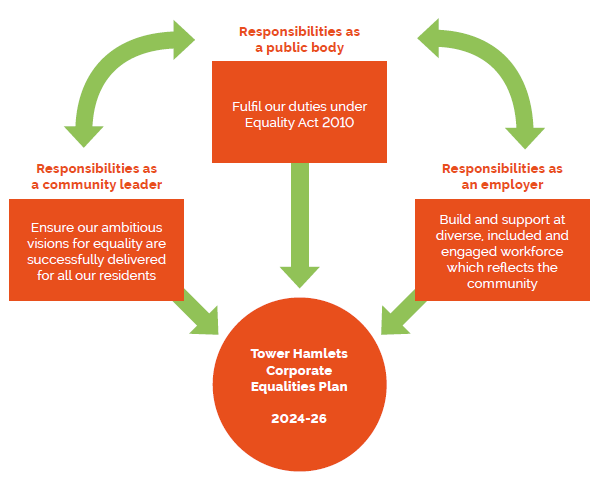2. Development of the Corporate Equalities Plan 2024-26
This Equality Plan aims to systematically address inequality, discrimination and disadvantage for Tower Hamlets residents and our own workforce. There are three key drivers which create the need for a comprehensive and strategic Equality Plan:
1. To ensure our ambitious vision for equality is successfully delivered for all our residents;
2. To fulfil our duties and responsibilities under the Equality Act 2010 as a public body;
3. To build and support a diverse, included and engaged workforce and meet our responsibilities as an employer.
In developing our Corporate Equalities Plan 2024-26, we used information from the Borough Equality Assessment and our Borough Profile which includes an analysis of Census 2021 data. The Borough Equality Assessment (BEA) is an assessment of inequality in Tower Hamlets and uses intelligence from national, regional and local data; engagement with local people through our equality forums; and engagement with council and partner services to identify inequality and performance challenges. The BEA is supplemented by our borough profile which provides data to enable us to understand our progress and areas of continuous challenges. The borough profile brings together the key facts and figures about Tower Hamlets into one consolidated report and presents the challenges and opportunities that make up the fabric of the borough.
We conducted an analysis of Census 2021 data and have used this to update the Borough Equalities Assessment in 2024. Some key highlights from the 2021 Census data includes:
- We have the fastest growing population of any local authority area across England and Wales. Between 2011 and 2021 the local population has grown by 56,200 (22.1%) to310,300.
- We are the most densely populated borough in England with 15,695 residents per square kilometre compared to an average of 424 per square kilometre in England.
- The Median Age in Tower Hamlets is 30 – the youngest of any area in England and Wales. The borough has the smallest proportion of older people aged 65+ in England and Wales.
- The most common countries of birth other than the UK are Bangladesh, Italy, India, China and France. 14% of residents were born in a current European Union country.
- Population Turnover is high compared to elsewhere, with more than a fifth (20.8%) of residents having lived somewhere else a year prior to the census.
- At 34.6%, we have the largest Bangladeshi population in England and Wales and the largest Muslim population (39.9%) in England and Wales. We have the fourth smallest White British population and the smallest Christian population in England and Wales.
- 7.2% of adult residents consider themselves as Lesbian, Gay, Bisexual or Other(which is the 9th highest percentage in England and Wales) and 1% have a gender identity different to their sex registered at birth (the 9th highest percentage in England and Wales).
- 62.7% of all residents in employment are in managerial, professional, or associate professional occupations but 46,000 adults have never worked.
- We have a high proportion of households who rent, both from social landlords and from private landlords, whereas the proportion of owner occupiers is the lowest in England and Wales.
- 15.8% of households are overcrowded (had too few bedrooms for their needs).
- 12.9% of residents identified as having a disability and 25.7% of households had at least one disabled person living within them.
- 6.4% of residents aged 5+ are providing unpaid care to someone else.
- The ethnic employment gap among women is twice as wide in the borough (41%) than in London (13.9%) in 2019-21.

Next page: Our key equality priorities